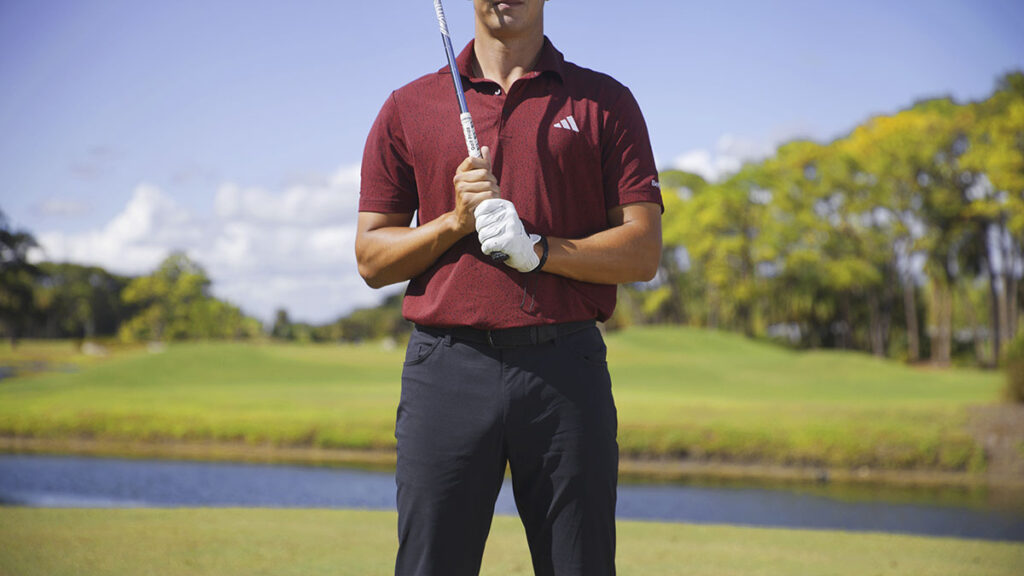Fast hands and level hips fuel Michael Thorbjornsen’s electric swing.
In his first full season on the PGA Tour, Michael Thorbjornsen (“Thor” for short) is really bringing the hammer. Through mid-October, the 24-year-old former Stanford University All-American ranked sixth on tour in driving distance (318.5 yards/291.2 metres) and second in total driving. Much of Thorbjornsen’s power and consistency comes from a big, wide backswing turn and solid clubface control, which he achieves by having very “fast hands” on the downswing, says his father and swing coach, Ted Thorbjornsen.
Michael’s hands separate quickly from his right shoulder as he transitions forward [above, fifth image], a trait he shares with his idol, Tiger Woods. Having fast hands also provides “insurance against him flipping the hands and clubhead through impact and hitting a hook”, says Ted, noting Michael’s lifetime use of a 10-finger or baseball-bat grip.
“For the clubhead to flip over, the hands have to stop,” Ted says. “But if there’s speed in the hands at impact, there’s little chance the clubhead can overtake his hands and flip.”
Ever since Thorbjornsen started playing golf, fast hands has been one of his big go-to feels. Another one, he says, has been to “keep his head very still on the downswing”, which helps prevent him from coming in too steep on the ball. Lately, however, Thorbjornsen’s focus has been on creating more depth and keeping his hips level in the backswing.
By rotating deeper into his right hip and getting his hands and the club further behind him on the backswing [above, fourth image], Thorbjornsen gives his “body more time to catch up” on the downswing, Ted says. At times, Michael’s hands can get too fast and out in front of his body, often producing too much of a draw. “For Michael’s stock shot, his shoulders are fairly aligned with the target line at impact, and his hands are closing the clubface sufficiently enough to hit his patented little draw,” Ted says.
Michael’s left knee also gives way in the backswing, which promotes a big hip turn and also keeps his hips fairly level at the top. With a reasonably steady head and level hips, Michael has a much easier time transferring his weight into the inside of his left leg in the downswing. That shift then lets him fire his hands down towards the ball to deliver real speed into the strike.
“You can see his back still faces the target, and his hands are separating quickly from his right shoulder,” Ted says. “That’s the hand speed I was talking about. His shoulders are quite level, too, so he can trap and cover the ball as well. He wants to feel that he’s covering the ball, not falling backwards and flipping the clubhead through.”
By mid-October, Michael had two top-four finishes in his rookie campaign.

Batter up?
Michael Thorbjornsen has played golf with the same grip since he was a toddler – and it’s a highly unusual one in the professional ranks. For as long as he can remember, the 24-year-old former US Junior Amateur champion – now in his first full season on the PGA Tour – has been using a 10-finger, “baseball-bat” grip. He doesn’t interlock or overlap his right-hand’s pinky with his left-hand’s index finger, as most right-handed golfers do.
“If you’re going to grab a bat or anything other than a golf club, you don’t really overlap or interlock,” says Thorbjornsen, describing the two most popular styles of grips in golf. “It feels the most comfortable to me. We probably should’ve made a change early on, but at this point, I’ve had so many years under my belt with this one, there is no point in changing now.”
It might come as a surprise to you that use of the 10-finger grip was much more popular among pro golfers decades ago. Among the notable players to excel with it were major champions Bob Rosburg and Art Wall Jnr, and LPGA Hall of Famer Beth Daniel.
“The Vardon [overlap] grip was by far the most important grip for decades,” says Jim McLean, one of Golf Digest’s Legends of Golf Instruction. “It was taught by just about everyone. But when Jack Nicklaus, then Tiger Woods, used the interlock, that turned the tables. Now a large majority of the top players in the world use the interlocking grip.”
The overlapping and interlocking grips have a unifying effect, McLean says, and make it much more difficult for one hand to take over the swing. “The idea is that the hands are working together and not opposing each other,” McLean says.
That said, McLean also believes there is a place in the game for the 10-finger grip, especially for those
golfers who struggle with an open clubface at impact and/or golfers who want to hit more draws (right-to-left curve for righties). It’s no coincidence that a draw happens to be Thorbjornsen’s stock shot.
“You definitely have more feeling in your [dominant] hand and more ability to release the club,” McLean says. “For [a righty] who cannot get the rotation of the right forearm to hit a draw, this grip can be the
simple solution to turn the ball over.”
Photography by Matt Tannehill




